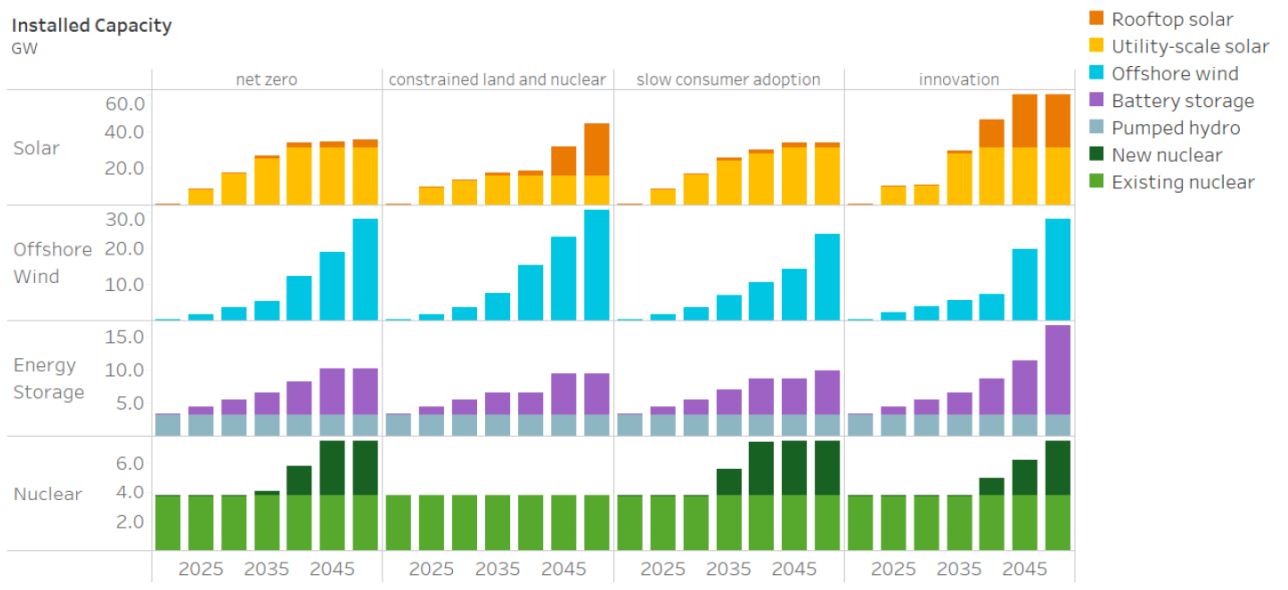
Where Virginia’s energy will come from in Bill Shobe’s 2050 zero-carbon future. Click for larger image.
by James A. Bacon
Bill Shobe, a professor of public policy at the University of Virginia, has outlined an approach to decarbonize Virginia’s economy — not just its electric grid, but the entire economy — by 2050. The scenarios and policies described in “Decarbonizing Virginia’s Economy: Pathways to 2050” may sound “out there” right now, but they seem fully consistent with what I’m hearing elsewhere in the environmental movement. There is so much momentum for a zero-carbon future that the document can be viewed as a roadmap of issues that Virginia environmentalists will be pushing over the next three decades.
The first priority is carrying out the decarbonization of the electric power industry, which accounts for approximately 30% of all of Virginia’s greenhouse gas emissions. As this has already been mandated by the Virginia Clean Economy Act, there’s little new in this particular aspect of the study. Virginia will have loads more wind, loads more solar. There is only one surprise. Shobe does not appear to labor under the illusion that Virginia can maintain grid stability through energy storage alone. He sees a continued role for nuclear energy to provide baseload power when a large majority of power production comes from intermittent wind and solar.
Next on the agenda will be wringing out CO2 emissions from the transportation sector through “electrification” — converting all vehicles to electric power. Virginia is just beginning to come to grips with that long-term goal as it debates electric-powered school buses and, more consequentially, the Transportation and Climate Initiative. Shobe’s timeline says to “electrify everything (almost)” by the 2030s. By the 2040s, Virginia will have completed electrification of transport and buildings as well.
Perhaps most controversial from a Greenie perspective is Shobe’s suggestion that Virginia will continue to need nuclear power. “Solar, offshore wind and existing nuclear are the foundation,” he says. Indeed, three of his four scenarios envision a doubling of nuclear-power generation. Dominion Energy’s bid to relicense its existing nuclear power licenses is controversial in the environmental community. The notion of building new nuclear capacity — the cost has been estimated to run as high as $20 billion — is an idea that only Dominion could love.
There is a wave-the-magic-technology wand element to Shobe’s analysis. In particular he expects “hydrogen” fuel to become economically practicable. Hydrogen fuel is another term for fuel cells, which extract the power generated by the combination of oxygen and hydrogen, creating water vapor as a byproduct. Maybe fuel-cell and battery technology will become commercially feasible in time to reach the 2050 goals, maybe they won’t.
I have no objections to creating a zero-carbon energy future. Over a long-enough time span, humanity will consume most of its fossil fuels and there will come a point at which we will have no choice but to rely upon nuclear and/or renewables. My concern is the accelerated timetable for getting to that future. What will the cost be? How reliable will the energy system be? And how vulnerable will our society be to catastrophic failure?
Solar is indubitably the least expensive power source today. More solar is good… to a point. That point is about 30% of the power on the electric grid. As utilities invest more in “smart grid” capabilities that allow for more flexibility in the flow of electricity throughout transmission lines and distribution lines, that percentage will increase. The real concern isn’t handling daily fluctuations in power generation and demand, though, it’s building an electric grid that can withstand rare but extreme weather events that simultaneously spike demand and cripple output for as much as a week at a time. Building resilience into the grid is all the more imperative as the entire economy goes fully electric.
The closer we get to 100% electrification, the more vulnerable we will become to catastrophic, systemwide collapse should the grid fail. The only way to avert the total economic and social breakdown is to build a lot more redundancy into the system. Our backups will need backups — and that includes protections against cyber-sabotage, terrorism and solar electro-magnetic storms. Massive redundancy will be massively expensive — a reality that rosy zero-carbon scenarios do not take into account. The notion that we can get to zero carbon by 2050 without taking potentially catastrophic risks is a pipe dream — a very dangerous pipe dream.
If Shobe wants to lay out pathways and strategies for reaching a zero-carbon society, I’m fine with that. But you’ve got to be very, very careful with a something as complex as the energy system. You must proceed cautiously, allow time for hoped-for technologies to commercialize, collect real-world feedback, make adjustments, and continually re-evaluate. The idea of giving politicians the power to monkey around with that complex system and enforce arbitrary timelines for the total restructuring of our energy economy should terrify every thinking person.


